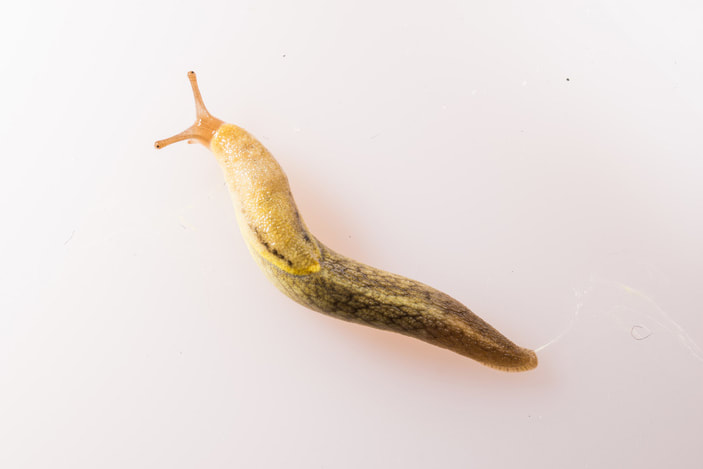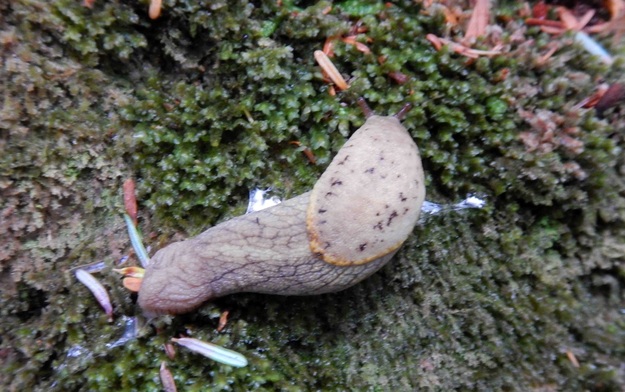Yellow-bordered taildropper • Prophysaon foliolatum
Identification
This yellowish to brownish-grey slug gets its name from its ability to self-amputate part (25%-33%) of its tail as an escape response when faced with predators. The point of breakage may appear as a thin line, along which constriction may become visible when the slug feels threatened. A web of thin dark lines forms a diamond mesh pattern on the tail, and the mantle has a yellow border and dark blotches or wide strips running along either side. The foot is cream-coloured and fringed with thick dark vertical lines. This slug gets to 9 cm long.
Habitat & Range
This species is found in forested regions in northwest North America. It can be found in and on woody debris, including snags, and may climb up to 3 m off the ground. In wet coastal temperate rainforest it may be found in association with skunk cabbage and devil's club.
Similar Species
Among the four other taildropper slugs found in the Pacific Northwest, the reticulate taildropper (Prophysaon andersonii) is most similar. It is smaller, lacks the yellow mantle border, and lacks the dark vertical lines along the foot fringe. The sole of the foot is bright white.
iNaturalist
https://www.inaturalist.org/taxa/228801-Prophysaon-foliolatum
This yellowish to brownish-grey slug gets its name from its ability to self-amputate part (25%-33%) of its tail as an escape response when faced with predators. The point of breakage may appear as a thin line, along which constriction may become visible when the slug feels threatened. A web of thin dark lines forms a diamond mesh pattern on the tail, and the mantle has a yellow border and dark blotches or wide strips running along either side. The foot is cream-coloured and fringed with thick dark vertical lines. This slug gets to 9 cm long.
Habitat & Range
This species is found in forested regions in northwest North America. It can be found in and on woody debris, including snags, and may climb up to 3 m off the ground. In wet coastal temperate rainforest it may be found in association with skunk cabbage and devil's club.
Similar Species
Among the four other taildropper slugs found in the Pacific Northwest, the reticulate taildropper (Prophysaon andersonii) is most similar. It is smaller, lacks the yellow mantle border, and lacks the dark vertical lines along the foot fringe. The sole of the foot is bright white.
iNaturalist
https://www.inaturalist.org/taxa/228801-Prophysaon-foliolatum
References
Forsyth, R. Prophysaon foliolatum (Gould in A. Binney, 1851). In Klinkenberg, Brian. (Editor) 2017. E-Fauna BC: Electronic Atlas of the Fauna of British Columbia. Lab for Advanced Spatial Analysis, Department of Geography, University of British Columbia, Vancouver. Accessed 29/08/2017.
Ingram, D. (2010). Taildroppers. Island Nature. Accessed 29/08/2017.
Prophysaon foliolatum (Gould, 1851) Yellow-bordered Taildropper. Mollusc Key. Evergreen State College, Olympia, Washington. Accessed 29/08/2017.
Prophysaon andersonii. Terrestrial Mollusc Tool. Center for Plant Health Science and Technology. Accessed 29/08/2017.
Authors and editors of page
Kelly Fretwell (2017)
Forsyth, R. Prophysaon foliolatum (Gould in A. Binney, 1851). In Klinkenberg, Brian. (Editor) 2017. E-Fauna BC: Electronic Atlas of the Fauna of British Columbia. Lab for Advanced Spatial Analysis, Department of Geography, University of British Columbia, Vancouver. Accessed 29/08/2017.
Ingram, D. (2010). Taildroppers. Island Nature. Accessed 29/08/2017.
Prophysaon foliolatum (Gould, 1851) Yellow-bordered Taildropper. Mollusc Key. Evergreen State College, Olympia, Washington. Accessed 29/08/2017.
Prophysaon andersonii. Terrestrial Mollusc Tool. Center for Plant Health Science and Technology. Accessed 29/08/2017.
Authors and editors of page
Kelly Fretwell (2017)






